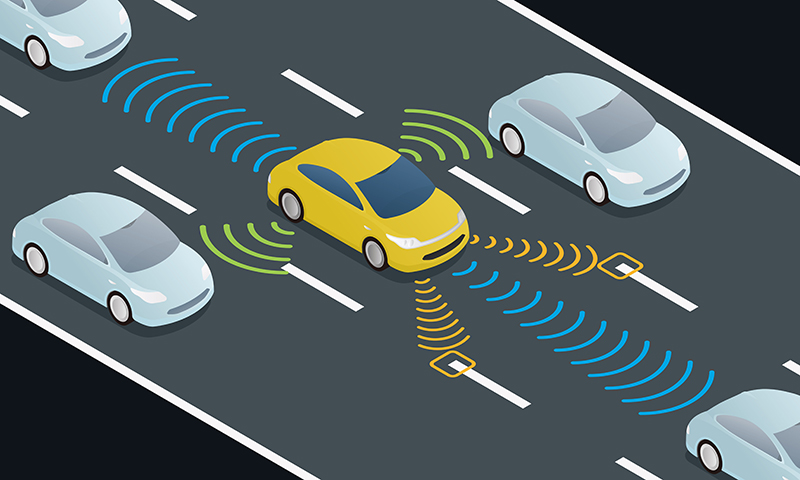What does the future hold for self driving cars?

Published: Thursday, 09 February 2023
Have you ever dreamed of having your own personal driver? This dream may not be as far away as you think with experts predicting that a fully-successful self-driving car should be on the market in 10-15 years time - but what are the pros and cons associated with this technology?
What are self driving cars?
In a nutshell, a self-driving car or driverless car is a type of vehicle that doesn’t require a human operator whilst it is in transit.
Instead, these cars travel via a combination of sensors, cameras, radar, artificial intelligence (AI) to reach their destinations. The vast majority of self driving cars are powered by electricity - meaning owners can enjoy the benefits of lower energy costs and EV charging too. To qualify as driverless, the car must be able to navigate itself to a predetermined destination without human intervention, using routes that may have not yet been adapted for its use.
A number of manufacturers have already begun building their own model of self driving car, including Audi, BMW, Ford, Google, Tesla, Volkswagen and Volvo. The highest success rate for this type of vehicle so far includes Google’s Toyota Prii and Audi TT, navigating over 140,000 miles of California streets and highways.
It’s predicted that the public transport and delivery market will be one of the first industries to make the most of this technology: now London is making the move to EV buses, this could happen sooner than we might think.
The six levels of a self driving car
While these technological advances sound extremely optimistic, there are actually six levels of self-driving car development.
- Level Zero is a traditional car, with no automated features.
- Level One offers some automated features, such as maintaining a single lane, and cruise control.
- Level Two self driving cars can steer and accelerate without any intervention, but the driver can take back control at any point.
Passengers may only see a change in mechanics when the self-driving car reaches Level Three: rather than the driver leading the vehicle, this is where the car starts making decisions on behalf of the driver.
- Level Three takes over most driving features, but the driver can still override any actions.
- Level Four means that the vehicle can perform all driving tasks, but again, human override is still available.
- Level Five self driving cars are fully automated, with no need for any driving instruction or attention.
While these higher levels of driverless cars don’t need any form of human intervention to travel, differing regulations worldwide would limit the use of them on public roads.

How does a self driving car work?
Driverless cars are powered by AI. The more the system drives, the more data it can incorporate into this deep learning algorithm, enabling it to make more nuanced driving choices.
AI features that enable autonomous driving include image recognition systems, machine learning, and neural networks, to help each vehicle react to objects, pedestrians and road hazards in the same way a human driver would do.
Many of the cars available for consumers today have a lower level of autonomy, but still include the self-driving features noted below:
- Hands-free steering: although the driver still needs to pay attention, this feature centres the car so the operator doesn’t constantly have their hands on the wheel.
- Adaptive cruise control (ACC) down to a stop: automatically maintains a selectable distance between the driver's car and the car in front, causing the car to stop if it is too close.
- Lane-centering steering: takes over when the driver crosses lane markings, by automatically nudging the vehicle toward the opposite lane marking.
- Sustainable measures: the vehicle runs on electricity to keep energy costs down, and make for a more sustainable journey.
Pros and cons of driverless cars
Although this topic is still largely unexplored, experts believe that self-driving cars could benefit the environment, economy and public safety. However, there are also risks involving cybersecurity and the overall safety of this technology.
Advantages
- Safety
When it comes to self driving cars, the main hesitance is issues with safety. However, 90% of car accidents are in fact caused by human error, meaning that a self-driving car could actually make the roads safer in the long-run.
- Freedom
This technology allows for disabled people who cannot currently drive to experience the independence of driving.
- Sustainability
Most self-driving cars are fully electric or hybrid models, reducing the need for harmful fossil fuels to power them.
- Traffic reduction
Whilst also reducing the high volume of fumes created by high traffic levels and creating a more peaceful commute, the AI in self driverless cars can communicate with other vehicles around it, helping avoid traffic jams.
Disadvantages
- Expense
The research that has gone into manufacturing driverless cars has been extremely costly so far. This means the sale price of each vehicle is likely to reflect high research and production costs, making them inaccessible to many.
- Hesitance
As mentioned earlier, the main downfall is that people are hesitant to buy this technology due to the unknown. Unexpected hazards, breakdowns and braking speeds are all new situations in a self driving vehicle: for this technology to enjoy widespread use, drivers will have to thoroughly trust their car.
- Hacking and Malfunctions
Just like other technological advances, hacking will always be a possibility. An example of this could be the drivers personal details being hacked, or the cars directions being hijacked, meaning someone else could take control of the vehicle's steering and directions.
Reach your destination with YESSS Electrical
While every new technological advance has pitfalls, the many benefits of self driving cars mean we could be seeing a lot more of these vehicles on our roads in the future.
Shop our powerful range of EV chargers.

